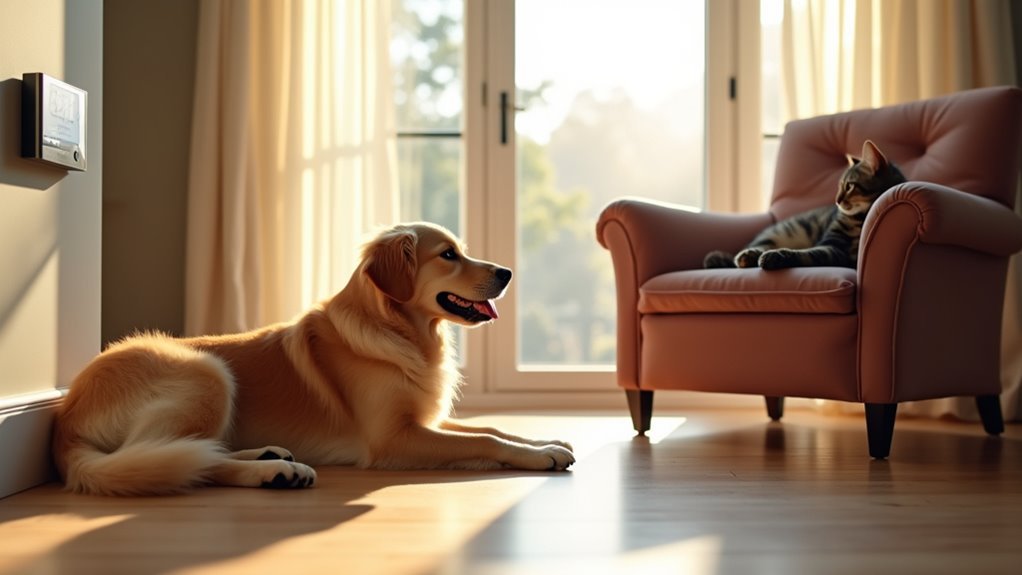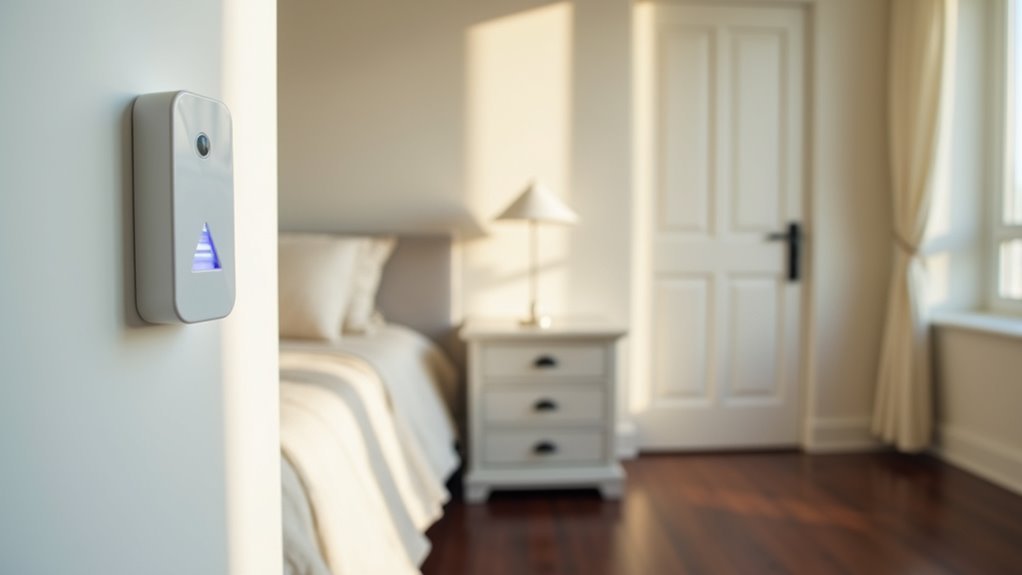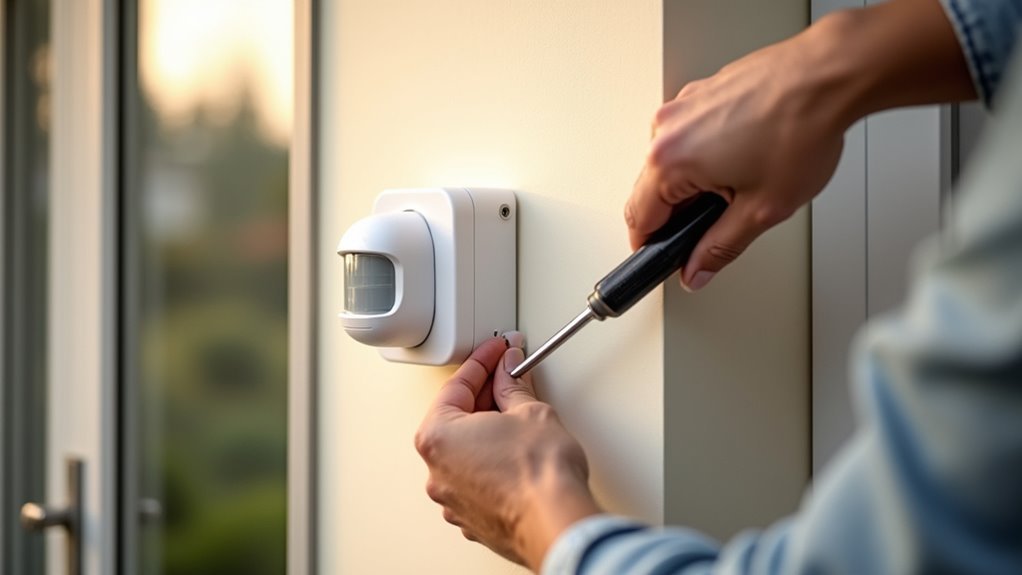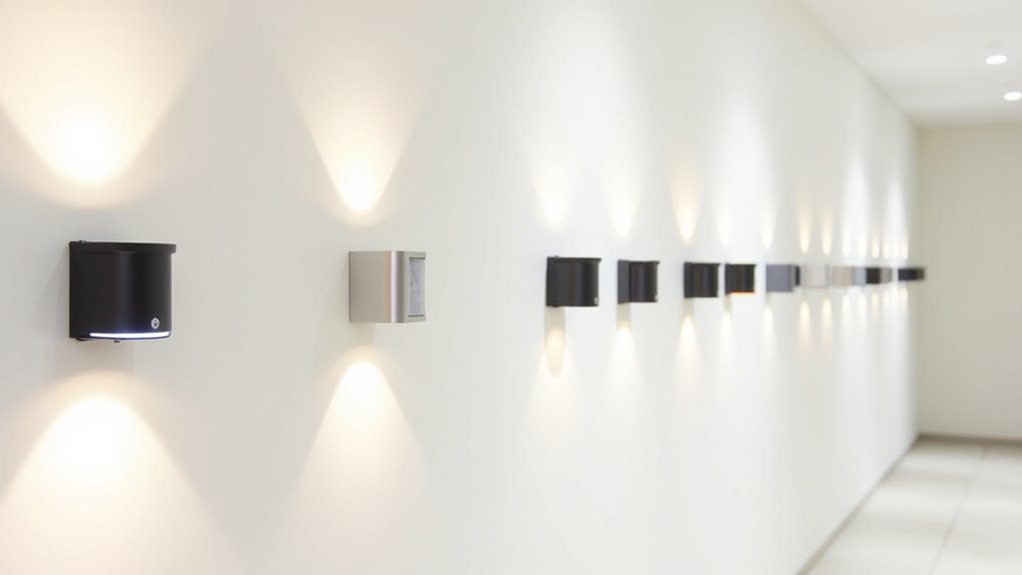You’ve probably noticed your pet seeking out specific spots in your home based on the temperature—under blankets when it’s cold or sprawling on cool tiles during summer heat. While you might think room temperature works for everyone, your furry companions have unique comfort needs that standard thermostats can’t address. The right temperature control strategy doesn’t just keep your pets comfortable; it can prevent serious health issues you might not even realize they’re experiencing.
Understanding Your Pet’s Temperature Comfort Zone

When you’re setting your home’s temperature, understanding that your pet’s comfort zone differs greatly from your own preferences is essential for their health and well-being.
The ideal indoor temperature for dogs during summer falls between 75-78°F, preventing heat stress while maintaining pets comfort. However, you’ll need to adjust these settings based on your dog’s specific characteristics.
Keep your dog’s indoor temperature between 75-78°F during summer, but adjust based on your pet’s breed and size.
Short-haired breeds require warmer air, around 78-80°F when you’re away. Small dogs lose heat rapidly, necessitating higher temperatures than larger breeds.
Older dogs and those with health issues benefit from consistent 72-78°F year-round.
Monitor your pet’s behavior for signs of discomfort or lethargy, as these indicators help you fine-tune keeping your home at suitable temperature levels for your furry companion’s needs.
Choosing the Right Smart Thermostat for Pet Households
How can you make certain your furry friends stay comfortable while you’re away? Smart thermostats offer the ideal solution for pet households.
Choose models with programmable settings to maintain consistent indoor temperatures between 75-78°F, ensuring your pets’ comfort while maximizing energy savings. Remote access capabilities let you monitor and adjust settings from your smartphone, giving you peace of mind when you’re not home.
Consider these essential features when selecting your smart thermostat:
- HVAC system zoning integration – Create customized temperature zones where your pets spend most time
- Humidity sensors – Prevent overheating during high-humidity days to keep pets comfortable
- Maintenance reminders – Never miss filter changes that protect your pet’s respiratory health
- Real-time monitoring – Track humidity levels and indoor temperatures continuously for ideal pet comfort
Setting Optimal Temperature Ranges for Different Pet Breeds

You’ll need to adjust your thermostat settings based on your pet’s specific characteristics rather than using a one-size-fits-all approach.
Your dog’s coat type, size, and age greatly impact their comfort level and temperature preferences throughout the year.
Consider these three key factors when programming your smart thermostat to guarantee you’re maintaining the ideal environment for your furry family member.
Coat Type Temperature Needs
Three key factors determine your pet’s ideal indoor temperature: coat thickness, body composition, and overall health status. Your heating and cooling system settings should reflect your dog’s specific coat type.
Long-haired breeds with thick coats need cooler environments around 75°F to prevent overheating, while short-haired dogs require warmer settings near 78°F for peak comfort. Keeping your dog at the right comfortable temperature means considering their unique physical characteristics.
- Your beloved companion depends on you to recognize their temperature needs
- A shivering pet breaks your heart and signals immediate action needed
- Overheated dogs can suffer serious health consequences that devastate families
- Temperature fluctuations cause unnecessary stress and discomfort for your furry family member
Monitor your pet’s behavior closely, adjusting your thermostat based on their coat type and individual needs.
Size-Based Climate Preferences
When determining the perfect temperature for your home, your pet’s size plays an essential role in their comfort and well-being. Understanding size-based climate preferences helps you create a comfortable environment that meets your dog’s specific needs.
Small dogs lose heat rapidly due to their higher surface-area-to-volume ratio, requiring warmer temperatures around 75-78°F. Larger breeds retain heat more effectively and can handle cooler temperatures within the safe range, though you shouldn’t exceed 80°F.
| Dog Size | Ideal Temperature Range |
|---|---|
| Small Dogs | 75-78°F |
| Large Dogs | 70-78°F |
| Puppies | 72-78°F |
| Senior Dogs | 72-78°F |
| All Sizes (Maximum) | 80°F |
Consider creating specific areas with appropriate temperatures to accommodate different-sized pets in multi-dog households.
Age-Specific Comfort Settings
As your pet ages, their temperature preferences shift greatly, requiring you to adjust your home’s climate settings to match their changing physiological needs.
Young puppies need age-specific comfort settings with indoor temperatures around 78-80°F to support their developing bodies. Their immature systems can’t regulate heat effectively, making a warmer environment essential for healthy growth.
Senior dogs typically prefer slightly elevated temperatures between 72-75°F. Arthritis and joint stiffness become more prevalent with age, and maintaining comfortable warmth helps alleviate their discomfort considerably.
Consider these emotional comfort factors:
- Your puppy’s tiny body shivers without adequate warmth
- Senior pets suffer silently from cold-induced joint pain
- Temperature stress weakens your pet’s immune system
- Comfortable pets live happier, longer lives
Understanding breed-specific needs alongside age requirements guarantees your furry family member stays comfortable throughout their entire lifetime.
Programming Seasonal Temperature Schedules for Pet Comfort

Since your pet’s comfort needs change dramatically between seasons, programming your thermostat with specific schedules becomes essential for maintaining their well-being year-round.
You’ll want to set different temperature ranges that align with your pets’ daily routines and seasonal requirements.
During summer months, program your thermostat to maintain 75-78°F during the day, then lower it slightly in the evening as your home naturally cools.
For winter, set temperatures around 68-72°F during the day, adjusting upwards for older or short-haired pets requiring extra warmth.
Monitor your pet’s behavior regularly to fine-tune these programmed settings.
Consider integrating smart technology that enables remote monitoring and adjustments, giving you flexibility to respond to unexpected weather changes or your pet’s specific comfort needs throughout each season.
Creating Climate Zones for Multi-Pet Households
Multi-pet households face unique challenges when different breeds have conflicting temperature needs, making HVAC zoning systems an invaluable solution for maintaining harmony.
You can designate specific rooms for pets with varying requirements—cooler spaces for long-haired breeds and warmer areas for short-haired or elderly companions.
- Watch your Golden Retriever finally relax in their cool sanctuary while your Chihuahua stays cozy
- Create personalized comfort zones where each pet thrives instead of merely surviving
- Eliminate the heartbreak of seeing pets struggle with uncomfortable temperatures
- Transform stressful climate conflicts into peaceful, pet-friendly environments
Use programmable thermostats to adjust temperatures based on daily routines.
Strategic placement of vents guarantees proper air circulation throughout zones.
Monitor temperature levels regularly and observe your pets’ behavior to fine-tune settings for peak comfort.
Monitoring Indoor Air Quality With Smart Sensors
While temperature control keeps your pets comfortable, maintaining clean air quality guarantees they actually stay healthy in those perfectly climate-controlled spaces.
Smart sensors continuously monitor your home’s indoor air quality, detecting pet dander, dust, and allergens that affect both you and your pets. These devices alert you when air quality drops, prompting immediate action like improving ventilation or adjusting your HVAC system settings.
Advanced smart sensors integrate seamlessly with your existing temperature control systems, automatically adjusting humidity and airflow based on real-time readings.
You’ll receive detailed insights and historical data showing air quality trends, helping you make informed environmental decisions. Regular monitoring prevents respiratory issues in pets, especially those with allergies or health conditions, creating a healthier living space for everyone.
Automating Temperature Adjustments When Away From Home
You can’t always be home to adjust your thermostat, but your pets still need comfortable temperatures throughout the day.
Smart thermostats offer automated scheduling, remote monitoring capabilities, and energy-efficient programming that keeps your furry friends comfortable while reducing utility costs.
These devices let you maintain ideal temperatures for your pets whether you’re at work, traveling, or simply want to eliminate the guesswork of manual temperature control.
Smart Thermostat Benefits
Smart thermostats revolutionize pet care by automatically maintaining ideal temperatures when you’re away from home.
These intelligent devices guarantee your pets a comfortable environment by keeping temperatures within the best 75-78°F range during summer months. Through smartphone apps, you’ll monitor and make temperature adjustments remotely, providing peace of mind about your pet’s wellbeing.
Smart thermostats learn your preferences and create schedules that align with your routine, reducing energy consumption while prioritizing pet comfort.
When integrated with home automation systems, they’ll alert you to temperature fluctuations requiring immediate attention.
- Never worry about your beloved pet suffering in extreme temperatures again
- Feel confident knowing your furry family member stays safe and comfortable
- Enjoy peace of mind while traveling, knowing your pet’s environment remains stable
- Protect your precious companion from dangerous temperature swings
Remote Monitoring Options
Three essential remote monitoring features transform how you protect your pets from temperature-related dangers while you’re away.
Smart thermostats equipped with remote monitoring capabilities let you adjust your HVAC system instantly through smartphone apps, ensuring your pets stay comfortable regardless of unexpected weather changes. Temperature alerts automatically notify you when your indoor environment drifts outside safe ranges, preventing heat stress or hypothermia before it occurs.
Remote sensors strategically placed throughout your home monitor temperature variations in different pet spaces, giving you full visibility of microclimates.
These sensors work seamlessly with your thermostat to maintain consistent comfort levels. Integration with home security systems creates a thorough monitoring solution, allowing simultaneous control of temperature settings alongside other home functions from anywhere worldwide.
Energy Efficient Scheduling
While maintaining your pets’ comfort remains the top priority, automated scheduling lets you reduce energy costs without compromising their safety.
Your programmable thermostat can automatically adjust temperatures to 75-78°F when you’re away, keeping pets comfortable while conserving energy. Schedule adjustments to occur before you return home, ensuring your furry companions enjoy ideal comfort without wasteful heating or cooling throughout the day.
Consider implementing zoning systems to target specific areas where your pets spend time. Monitor seasonal changes and adjust your HVAC system accordingly.
- Peace of mind knowing your beloved pets stay comfortable even when you’re not home
- Significant savings on monthly energy bills without sacrificing pet welfare
- Smart scheduling that anticipates your family’s needs automatically
- Guilt-free energy conservation that benefits both your wallet and the environment
Integrating Smart Fans and Ventilation Systems
When temperatures fluctuate throughout the day, integrating smart fans and ventilation systems into your home creates an automated solution that keeps your pets comfortable without constant manual adjustments.
These systems monitor temperature and humidity levels, automatically adjusting airflow to maintain ideal indoor temperatures for your furry companions.
Smart ceiling fans enhance air circulation by creating gentle breezes that help cool pets during hot weather while distributing conditioned air effectively throughout your space.
Many models include occupancy sensors that activate only when pets or humans are present, maximizing energy efficiency.
You can program smart ventilation systems to open or close based on indoor and outdoor conditions, ensuring consistent air quality.
This integration with thermostats reduces overall costs while maintaining a stable pet-friendly climate year-round.
Using Mobile Apps to Monitor Pet Environment Remotely
You can transform your smartphone into a powerful monitoring tool by connecting it to your smart thermostat through dedicated mobile apps.
These apps give you real-time control over your home’s temperature, letting you adjust settings instantly when you’re at work or traveling.
You’ll receive immediate alerts if temperatures spike or drop beyond your pet’s comfort zone, allowing you to respond before your furry friend experiences any distress.
Smart Thermostat Integration
As technology continues to advance, smart thermostats have revolutionized how pet owners maintain perfect home environments for their furry companions.
These devices seamlessly integrate with mobile apps, allowing you to monitor temperature fluctuations and make real-time adjustments from anywhere. You’ll receive instant alerts when conditions change, ensuring your pets stay comfortable while you’re away.
Smart thermostats provide energy usage statistics that help you balance comfort and efficiency during peak seasons.
Program custom schedules that work with your routine and your pet’s needs, reducing separation anxiety through consistent temperatures.
- Never worry about your pet overheating during unexpected hot days
- Feel confident leaving home knowing you can adjust temperatures instantly
- Save money while keeping your beloved companion comfortable
- Create peace of mind through automated ideal environment controls
Real-Time Alert Systems
Beyond basic temperature monitoring, real-time alert systems transform your smartphone into a powerful guardian for your pet’s wellbeing.
These mobile apps instantly notify you when indoor temperatures exceed safe thresholds, preventing dangerous heat stress or cold exposure while you’re away. You’ll receive immediate alerts about humidity fluctuations and air quality changes that could affect your pet’s respiratory health.
Advanced systems let you adjust settings remotely, ensuring best pet comfort without wasting energy. The apps track usage patterns, helping you balance your pet’s needs with energy costs.
Some monitoring systems detect allergens and pollutants, sending alerts when air quality drops. You can create custom temperature schedules around your pet’s daily routine, maintaining ideal conditions while minimizing unnecessary heating and cooling expenses.
Maintaining HVAC Systems for Year-Round Pet Safety
While many pet owners focus on setting the right temperature, maintaining your HVAC system properly guarantees it’ll consistently provide safe, comfortable conditions for your furry friends throughout every season.
Keeping your HVAC system in peak condition protects pets from dangerous summer heat and winter chills.
Change air filters at least four times yearly, more frequently with pets, to prevent hair and dander buildup.
Schedule annual professional maintenance to avoid breakdowns during extreme temperatures.
Install pet-specific HEPA filters or air purifiers to capture allergens.
Protect outdoor units with barriers to prevent pet damage and injuries.
- Your beloved companion depends on you for life-saving temperature control
- Dirty filters could leave your pet gasping in stifling air
- System failures during heatwaves can be deadly for vulnerable animals
- Clean air means healthier, happier pets who’ll live longer lives
Frequently Asked Questions
Are Dogs Ok in an 80 Degree House?
Dogs aren’t ideal in 80-degree houses since they prefer 75-78 degrees. You’ll need to watch for panting, drooling, or lethargy. Provide fresh water, create cool spots, and use fans to help your dog stay comfortable.
What Temperature Should a House Be for a Pet?
You should keep your house between 75-78°F in summer and 68-72°F in winter for most pets. Adjust based on your pet’s breed, size, and coat thickness for ideal comfort.
What Temperature Should I Leave AC on for My Dog?
You should set your AC between 75-78°F when leaving your dog home alone. Don’t let it go above 80-82°F to prevent overheating and heat stress in your pet.
Is 75 Degrees Too Hot for a Dog?
No, 75 degrees isn’t too hot for your dog. It’s actually within the comfortable range for most breeds. You should monitor your dog’s behavior and guarantee they’ve got access to fresh water.





Leave a Reply